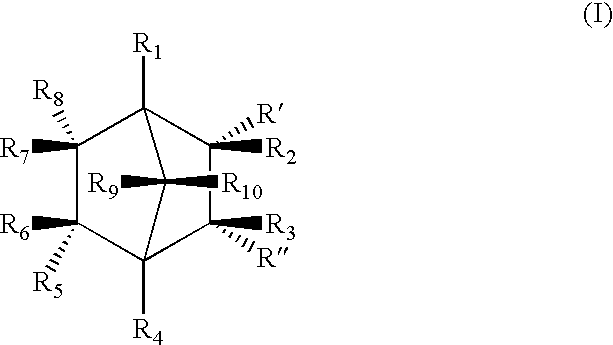Novel thermoplastic nucleating compounds
a technology of thermoplastics and nucleators, applied in the field of new thermoplastic nucleating compounds, can solve the problems of large-scale industrial applications, nucleator compounds, and each exhibit their own drawbacks, and achieve the effects of excellent calcium stearate compatibility, low hygroscopicity, and exceptional nucleation efficacy
- Summary
- Abstract
- Description
- Claims
- Application Information
AI Technical Summary
Benefits of technology
Problems solved by technology
Method used
Image
Examples
example 1
Hydrogen Sodium Bicyclo[2.2.1]heptane-2,3-dicarboxylate
[0032] 80.0 g (487.3 mmoles) of himic anhydride (164.16 g / mole) and 175 ml of water were charged into a 1L round bottom flask with stirring. To this solution was added 19.69 g (492.3 mmoles) of NaOH (40.00 g / mol). The solution was stirred with heat until all components were in solution. Upon cooling, crystals began to form and 500 ml of water was added to fully solubilize all solids. Palladium on activated carbon (5 wt %) was added to the aqueous solution. The mixture was transferred into a Parr reactor and was subjected to hydrogenation (50 psi, room temperature) for 8 hours. The activated carbon was filtered out, and the water was removed in vacuo at 75.degree. C. The resulting product (melting point greater than 300.degree. C.) was dried and milled. An IR analysis was consistent with that of the expected structure. GS-MS showed >99% saturation of the double bond.
example 2
Hydrogen Lithium / Sodium Bicyclo[2.2.1]heptane-2,3-dicarboxylate (Half Neutralized)
[0033] 82.0 g (500.0 mmoles) of himic anhydride (164.16 g / mole) and 175 ml of water were charged into a 1L round bottom flask with stirring. To this solution was added 10.00 g (250.0 mmoles) of NaOH (40.00 g / mol) and 5.99 g (250.0 mmoles) of LiOH (23.95 g / mol). The solution was stirred with heat until all components were in solution. Half of this solution was transferred to another IL round bottom flask. Upon cooling, palladium on activated carbon (5 wt %) was added to the remaining aqueous solution. The mixture was transferred into a Parr reactor and was subjected to hydrogenation (50 psi, room temperature) for 8 hours. The activated carbon was filtered out, and the water was removed in vacuo at 75.degree. C. The resulting product (melting point greater than 300.degree. C.) was dried and milled. An IR analysis was consistent with that of the expected structure. GS-MS showed >99% saturation of the doub...
example 3
Hydrogen Lithium / Sodium Bicyclo[2.2.1]heptane-2,3-dicarboxylate (Three Quarters Neutralized)
[0034] The other half of the solution of Hydrogen Lithium / Sodium bicyclo[2.2.1]heptane-2,3-dicarboxylate (half neutralized) solution was further neutralized with an additional 5.00 g (125.0 mmoles) of NaOH (40.00 g / mol) and 2.99 g (125.0 mmoles) of LiOH (23.95 g / mol). Upon cooling, palladium on activated carbon (5 wt %) was added to the aqueous solution. The mixture was transferred into a Parr reactor and was subjected to hydrogenation (50 psi, room temperature) for 8 hours. The activated carbon was filtered out, and the water was removed in vacuo at 75.degree. C. The resulting product (melting point greater than 300.degree. C.) was dried and milled. An IR analysis was consistent with that of the expected structure. GS-MS showed >99% saturation of the double bond.
PUM
| Property | Measurement | Unit |
|---|---|---|
| crystallization temperatures | aaaaa | aaaaa |
| melting point | aaaaa | aaaaa |
| melting point | aaaaa | aaaaa |
Abstract
Description
Claims
Application Information
 Login to View More
Login to View More - R&D
- Intellectual Property
- Life Sciences
- Materials
- Tech Scout
- Unparalleled Data Quality
- Higher Quality Content
- 60% Fewer Hallucinations
Browse by: Latest US Patents, China's latest patents, Technical Efficacy Thesaurus, Application Domain, Technology Topic, Popular Technical Reports.
© 2025 PatSnap. All rights reserved.Legal|Privacy policy|Modern Slavery Act Transparency Statement|Sitemap|About US| Contact US: help@patsnap.com


